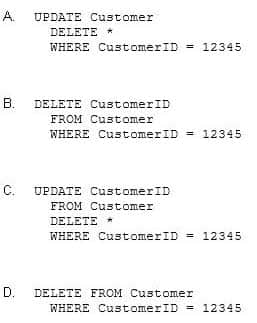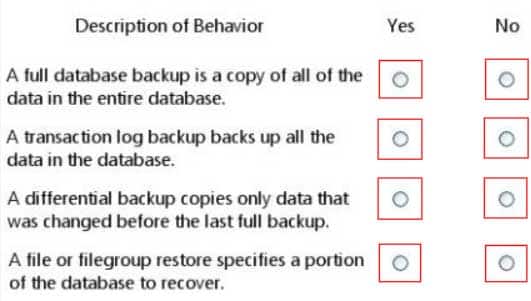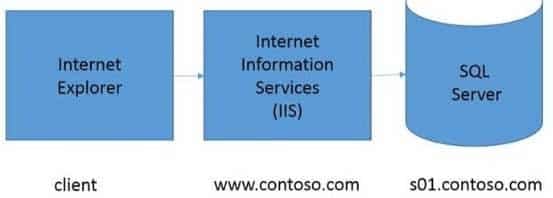98-364 : Database Fundamentals : Part 04
98-364 : Database Fundamentals : Part 04
-
Which two elements are required to define a column? (Choose two.)
- A name
- A key
- An index
- A data type
-
What defines the amount of storage space that is allocated to a value in a column?
- format
- key
- data type
- validator
-
You are creating a table to store customer data. The AccountNumber column uses values that always consist of one letter and four digits. Which data type should you use for the AccountNumber column?
- CHAR
- BYTE
- DOUBLE
- SMALLINT
-
What is one difference between an update statement and a delete statement?
- An update statement can change only one row.
- A delete statement cannot use a where clause.
- An update statement does not remove rows from a table.
- A delete statement works only within a stored procedure.
-
You have a Department table and an Employee table in your database.
You need to ensure that an employee can be assigned to only an existing department.
What should you apply to the Employee table?
- A primary key
- An index
- A foreign key
- A unique constraint
- A data type
-
You need to store the first name, last name, and student ID for 100 students.
This information will be stored in a table as:
- 100 items and three cells.
- 100 rows and three columns.
- three rows and 100 columns.
- three items and 100 cells.
-
What are three valid data manipulation language (DML) commands? (Choose three.)
- INSERT
- COMMIT
- DELETE
- OUTPUT
- UPDATE
Explanation:
Data manipulation languages have their functional capability organized by the initial word in a statement, which is almost always a verb. In the case of SQL, these verbs are:
– SELECT … FROM … WHERE …
– INSERT INTO … VALUES …
– UPDATE … SET … WHERE …
– DELETE FROM … WHERE … -
You assign User1 a set of permissions that include the WITH GRANT OPTION.
The WITH GRANT OPTION enables User1 to:
- request a log of permission use.
- delegate permissions to other users.
- create new database users.
- view other users’ permissions.
-
Which type of index changes the order in which the data is stored in a table?
- non-sequential
- sequential
- non-clustered
- clustered
-
Which statement should you use to remove a foreign key?
- ALTER TABLE
- DELETE TABLE
- DELETE FOREIGN KEY
- ALTER FOREIGN KEY
-
First normal form requires that a database excludes:
- Foreign keys
- Composite keys
- Duplicate rows
- Repeating groups
-
You execute a statement inside a transaction to delete 100 rows from a table. The transaction fails after only 40 rows are deleted.
What is the result in the database?
- The table will be corrupted.
- Forty (40) rows will be deleted from the table.
- The transaction will restart.
- No rows will be deleted from the table.
-
You have a table that contains product IDs and product names.
You need to write an UPDATE statement to change the name of a specific product to glass.
What should you include in the update statement?
- SET ProduetName = ‘glass’
- LET ProduetName = ‘glass’
- EXEC ProduetName = ‘glass’
- ASSIGN ProduetName = ‘glass’
-
Your database contains a table named Customer.
You need to delete the record from the Customer table that has a CusromerID of 12345.
Which statement should you use?

98-364 Part 04 Q14 019 - Option A
- Option B
- Option C
- Option D
-
On which database structure does an insert statement operate?
- Role
- Trigger
- User
- Stored procedure
- Table
-
You have a table of products with fields for ProductID, Name, and Price.
You need to write an UPDATE statement that sets the value in the InStock field to Yes for a specific ProductID.
Which clause should you use in your update statement?
- THAT
- WHERE
- GROUP BY
- HAVING
-
You have the following table definition:
CREATE TABLE Product
(ProductID INTEGER,
Name VARCHAR(20))You need to insert a new product. The product’s name is Plate and the product’s ID is 12345.
Which statement should you use?

98-364 Part 04 Q17 020 - Option A
- Option B
- Option C
- Option D
-
HOTSPOT
Instructions: For each of the following statements, select Yes if the statement is true. Otherwise, select No. Each correct selection is worth one point.

98-364 Part 04 Q18 021 Question 
98-364 Part 04 Q18 021 Answer -
HOTSPOT
The following graphic shows the components of a SQL Server application. You access the SQL Server application through Internet Explorer.

98-364 Part 04 Q19 022 Instructions: Use the drop-down menus to select the answer choice that completes each statement. Each correct selection is worth one point.

98-364 Part 04 Q19 023 Question 
98-364 Part 04 Q19 023 Answer -
You have the database table named Cars as defined below:

98-364 Part 04 Q20 024 You have the following Structured Query Language (SQL) statement:

98-364 Part 04 Q20 025 How many rows are returned by the SQL statement?
- 4
- 5
- 6
- 7